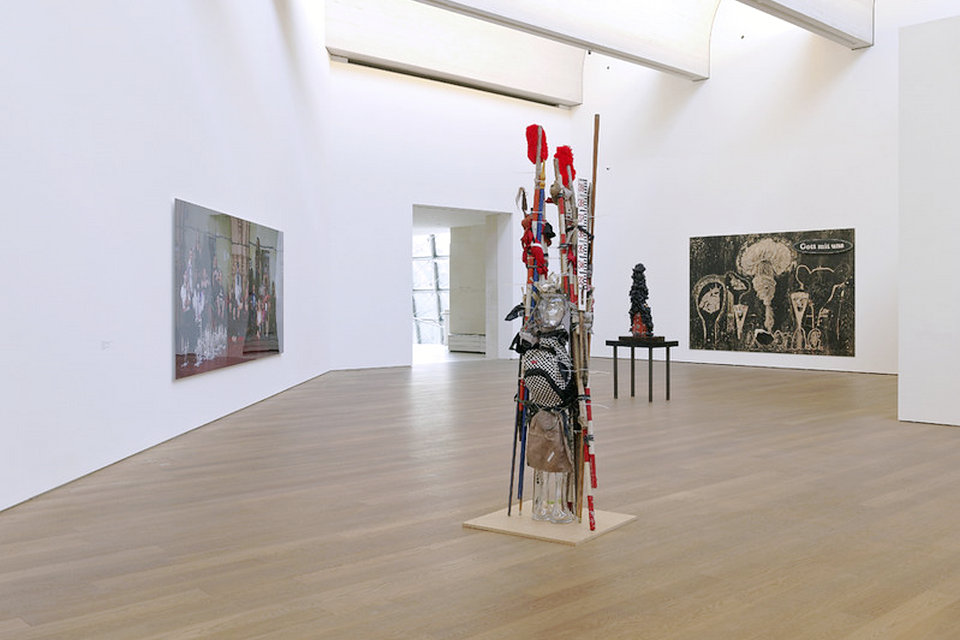Dieu est un fumeur de havanes, Museum of Modern Art Grand Duke Jean


Each era has its own beliefs with which to reassure and project itself; a constantly renewed quest for meaning to affirm the presence of Man at the centre of a universe that lies beyond his understanding, because since the dawn of time, the rational and the irrational have rubbed shoulders, science and faith oppose one another as much as they complement each other.
When all the involved calculations prove false, and the philosophers themselves have nothing more to tell us, it is excusable to turn to the random twitter of birds, or toward the distant mechanism of the stars. (Marguerite Yourcenar, Memoirs of Hadrien)
Unexplained phenomena thus give rise to myths and feed the imagination, as in the artworks of João Maria Gusmão and Pedro Paiva. Their 16 mm films stage enigmatic short stories (here, a mysterious shamanic dance with a serpent; there, an animal skeleton in movement; elsewhere, the exploration of a rocky recess lit by the glow of a flaming hand), numerous strange sequences that seem to capture paranormal experiences or ancestral rites. Halfway between anthropological research and pataphysical tales, the two artists become observers of a world in which magic and spirits are indistinguishable from the real.
Under the starry ceiling lies a sublunar world, the one we inhabit and which we thoroughly scrutinize and explore. Attentive to his environment and wishing to penetrate mysteries, Man constantly invents new tools: some of them are technologically sophisticated while others are more empirical. Trevor Paglen’s starry heavens, with their falsely romantic allure, in fact capture the twinkling of satellites and other observation devices pointed at the Earth while the installation titled Lantern by Francisco Tropa presents itself as a surprising optical instrument which triggers the apparition of an abstract landscape in movement and evokes a possible elsewhere, both infinitely big and infinitely small.
While scientific observation diversifies possible interpretations and sharpens our perception, the mystery remains intact. Science itself, when it seeks to explain the universe, becomes poetic and speculative like the fanciful licence found inBjörn Dahlem’s sculpture. The sensitive and evocative assembly of found objects confronts the visitor with Dahlem’s model of the famous Big Bang, the cosmological phenomenon at the origin of the universe, the discovery of which revolutionized our comprehension of the world while opening the path to multiple interpretations and an even greater number of questions.
Indeed, we are perhaps the custodians of the history of this very carefully observed world, yet we are far from a complete understanding of our origins. With humour, in the style of an archaeologist, Christian Andersson offers us an astonishing journey back in time: contemporary artefacts and objects combine and reassemble a potential chronology through association.
Our knowledge progresses a little more each day, but the assurance of a measurable and unchanging world no longer exists; the metaphysical comfort of an Aristotelian cosmos has been lost. Man is no longer at the centre of things, religions have been exceeded. So, how to exist in this vast world and these reconstructed societies when faced with others and oneself?
Certainly, we share cultural and religious symbols that artists often seize upon with distance and detachment: the curious sculpture God Stack by Edward Lipski tangles together the various divinities in joyful syncretism. Nevertheless, numerous are those who, through individual research, invent a personal mythology. Echoing the way in whichPascale Marthine Tayou adorns his glass idols, Kyoichi Tsuzuki’s Happy Victims surround themselves with their favourite clothes, like fetishes, thus displaying the same feeling of belonging to a community as the groups of fans brought together by Candice Breitz.
And then, faced with the masked apparitions of Pieter Hugo’s photographs, it would seem that no positivism, no rationalism can deprive the human mind of its share of fantasies and that for a long time to come we shall seek the answers to our questions in our dreams.
Museum of Modern Art Grand Duke Jean
Mudam is the foremost museum dedicated to contemporary art in Luxembourg, and strives to be attentive to every discipline. Its collection and programme reflect current artistic trends and appreciate the emergence of new artistic practices on a national and international scale.
Mudam Luxembourg – Musée d’Art Moderne Grand-Duc Jean opened in 2006 in a purpose-built building designed by the renowned Sino-American architect Ieoh Ming Pei and located in the Park Draï Eechelen, overlooking the historic city of Luxembourg. Through its collection, exhibitions, programmes and partnerships, Mudam Luxembourg aims to advance its mission to collect, present and make accessible the most relevant art of our times, for the largest public possible.
The museum building is located on the site of Fort Thüngen in the Dräi Éechelen park (“three acorns” – in reference to the three acorns that adorn the three towers of the fortress), designed by Michel Desvigne and located between the city center and the Kirchberg district (Europe district).
The guiding principle of the museum is “all-art”: in addition to the works of course, the functional furniture of the Mudam (armchairs, shop, cafe, website, offices) is also a creation of artist- designers. And this principle extends to archiving: photographer Pierre-Olivier Deschamps has been entrusted with the task of constituting the photographic memory of the construction of the museum.
In addition, many artists present in the collections belong to the world of design (fashion, decoration, sound design, graphics), the Mudam is therefore always at the border that separates “noble” art (the “free” gesture) of a more utilitarian art. This desire for “all-art” is entitled “Be the Artists’ Guest”.
The collections are not presented permanently and exhaustively, a rotation is organized in the form of exhibitions on the proposal of curators external or internal to the museum.